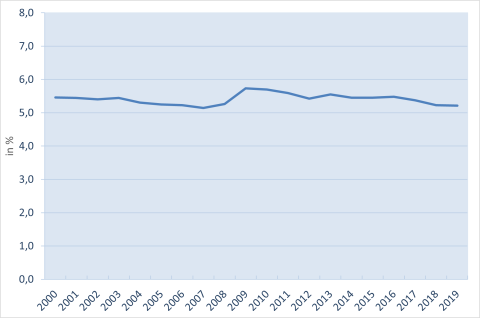After the Second World War until the mid-1970s, the Austrian economy developed positively and the labour market reached full employment. Welfare state benefits were steadily expanded. Therefore, Austria is labelled as welfare state or, in economic terms, social market economy.
The greatest political milestone in the Second Republic was Austria's joining the European Union (EU) on 1.1.1995. EU-Membership changed all aspects of political and economic life: Austria participates in the Economic and Monetary Union, the Austrian “Schilling” was replaced by the Euro as European currency on 1.1.2002. Austria carries out functions in the European Union and participates in the discussion on the developments of the EU and its institutions.
With accession to the EU, trade relations also strengthened: Around 80 % of foreign trade (imports and exports) are realised with European countries, around 68 % with EU member states. The most important export trading partner is Germany (30 %), followed by Italy (7 %), the USA (7 %), Switzerland (5 %), Poland (4 %), France, Hungary, the Czech Republic, China and the United Kingdom. Austria mainly exports machinery/vehicles, chemical products, iron and steel plus metal goods (data for 2021, source: Statistics Austria: Foreign trade statistics 2021, visited 31.08.2022).
After the global economic and financial crisis in 2008, the Corona pandemic (since 2020) and current challenges (Ukraine war, energy crisis, inflation, shortage of skilled workers) have had a negative impact on the Austrian economy. Although the unemployment rate rose (2021: 10 %), it could be kept relatively low compared to other EU countries with various measures, such as short-time work, investments in further training and corona assistance for companies. Currently (as of July 2022), an economic recovery can be observed with a forecast economic growth of almost 4 % for 2022 and 2 % for 2023 (source: Austrian Institute of Economic Research (WIFO): Economic Forecast 2/2022, visited 31.08.2022). Positive signals are also coming from the labour market: Employment in January 2022 was above the pre-crisis level again, and with 170,000 vacancies at the end of 2021, a new peak in demand of the companies for workforce was recorded. The unemployment rate in February 2022 was 7.3% (source: Statistics Austria: Press release 12.758-056/22 of 4th March 2022, visited 31.08.2022).
The largest economic sector in Austria is services (70 %), in particular trade, tourism and health care. Furthermore Industry (28%) comprising production, energy supply and construction is of high importance. With a share of 1.4% of the gross domestic product (GDP), the primary sector (agriculture and forestry) has a marginal relevance by now (source: Statistics Austria: National accounts, GDP by economic sector, visited 31.08.2022).
The business landscape is dominated by small businesses with 0-9 employees (88 %), of which 42 % are self-employed as single-person businesses (EPU) without employees. Small and medium-sized enterprises (SMEs, < 250 employees) are the backbone of the Austrian economy with 99.6 % of the enterprises in total (source: Statistics Austria: Performance and structural survey, companies by employee size class, visited 31.08.2022).
The education and training system in Austria is very strongly linked with the economy: 80% of dual training take place in companies, the contents of training are based on the needs of companies. Like the curricula of VET schools and colleges, the offers of the CET sector are also matched with the qualification requirements of the economy and the labour market. With the Universities of Applied Sciences (Fachhochschulen) in the early 1990s, a new and expanding type of VET programmes on tertiary level was implemented in Austria.
The most important current challenges for the Austrian political system are: securing the supply of skilled workforce & modernising vocational education and training (VET), combating unemployment & providing qualification, migration & integration, less bureaucracy & modernisation of the administration as well as policy measures in education and training. Based on the programme of the current federal government, the following steps are planned (Source: Federal Chancellery, Government Programme 2020-2024, visited 31.08.2022):
- Securing the supply of skilled workforce & modernising vocational education and training (VET)
Especially in tourism and care, the shortage of skilled workforce and personnel has become even more acute as a result of the Corona pandemic (e.g. through migration to other sectors of the economy). In addition, experts have been warning for years about upcoming skilled labour shortages across all sectors with reference to demographic developments (retirement wave of the baby boomer generations). A broad-based skilled labour offensive and the consistent upgrading and modernisation of vocational education and training are intended to safeguard jobs and Austria as a competitive business location for the future.
- Combating unemployment & providing qualification
According to the programme of the current government, the unemployment rate is not falling correspondingly to the recovering economy with the increase of job vacancies. In order to reduce unemployment, further employment incentives as well as modernisation and less bureaucracy in labour law are considered as crucial. As a contribution to improve the qualifications of young persons and to counteract youth unemployment, the "training obligation until 18" came into force in 2016. The "Training until 18" obliges young people up to the age of 18 to complete training beyond compulsory schooling and is supplemented by counselling services (career and educational guidance, youth coaching). (cf. Chapter 2.1.).
A key role in reducing unemployment in Austria has the Public Employment Service Austria: it supports jobseekers in finding a workplace, provides training according to individual and labour market requirements and cooperates with companies.
- Migration & Integration
In order to secure social peace in Austria, the federal government is in ongoing negotiations with the EU member states on the development of a common migration strategy. The refugee movement from Ukraine has intensified the domestic discussion on how refugees and persons granted asylum can be integrated into the labour market and the education system as quickly as possible. The reform of the citizenship law to facilitate access is not a political priority currently.
- Less bureaucracy and modernisation of the administration
Public administration needs to be optimised and made sustainable. This is to be achieved by quality improvements and the expansion of "digital administration", a citizen-focused approach and a plus of personal rights, transparency, efficiency increases, cost reductions and the effective use of public funds.
- Policy measures in education and training
Since the 1970s, the Austrian education system has been continuously modernised and expanded, e.g. through the following measures:
-
- Comprehensive expansion of after-school care and kindergartens to provide children with appropriate support and enable their parents to reconcile work and family life.
- Expansion of university education in order to create adequate and sufficient offers for academic training
- Implementation of universities of applied sciences to enhance tertiary vocational education and training (VET)
- Expansion of adult education, in particular in the area of vocational training offers, in order to support lifelong learning and to meet the requirements of the labour market.
One focus of the current government programme is on the modernisation/enhancement of dual training (keyword digitalisation, new occupational profiles in the field of climate/environmental protection, expansion of company cooperations and joint training, flexible training models). In addition, following the example of Switzerland and Germany, it is planned to develop the legal basis for a sector "higher vocational education and training" and to "upgrade" vocational qualifications (e.g. master craftsman). The aim is to establish a vocational pathway of higher qualification (e.g. for apprenticeship graduates) up to tertiary level with improved credits and recognised formal qualifications. "Lifelong learning" also remains on the political agenda with the expansion of adequate educational offerings for adults, strengthening of quality assurance and recognition of non-formal and informally (e.g. in working life) acquired competences ("validation strategy"). For the higher education sector, the government programme schedules to strengthen the permeability of the higher education system, to expand universities of applied sciences (Fachhochschulen) in line with demand and to reduce the (high) student dropout.
Well-developed education programmes for skilled workers and in the academic sector ensure the continuous access of qualified workforce to the labour market. As figure 1 shows, the level of education has continuously increased over time: In the course of the educational expansion of the last decades with the trend to acquire higher qualifications, the share of persons of prime working age (between 25 and 64 years) with compulsory schooling as highest qualification decreased from 58 % to 18 % between 1971 and 2020. Every third person in this age category had an apprenticeship qualification in 2020. Despite massive competition by schools to attract young people, more than 40% of an age cohort still opt for apprenticeship. Approximately 15% of the population aged 15-64 have an intermediate or higher (vocational) qualification at the upper secondary level. The unbroken trend towards higher qualification is also manifested in rising university graduation rates: While the share of university graduates was 3% in 1971, it has reached the 17% mark in 2020 (see figure 1).

Figure 1: Development of the educational attainment (population aged 25-64), in per cent
Source: Statistics Austria, Education Statistics, visited 29.08.2022; in house calculations
Figure 2 illustrates the development of the expenditure for education and training as a percentage of gross domestic product (GDP) between 2000 and 2019. The expenditure ratio covering the education sectors in total - from elementary to tertiary education and training - ranges relatively stable between 5.2% and 5.7% of GDP. Herewith Austria is at the level of the OECD average. In a multi-year comparison, about 10 % of the annual national budget flow into the education system. In 2020, around 21.6 billion euros were spent on education, more than twice as much as in 2000. (Source: Statistics Austria, Education expenditure over time, visited 29.08.2022).

Figure 2: Development of the expenditure on education and training in per cent of total GDP
Source: Statistics Austria, Education expenditure over time, visited 29.08.2022; in house calculations

